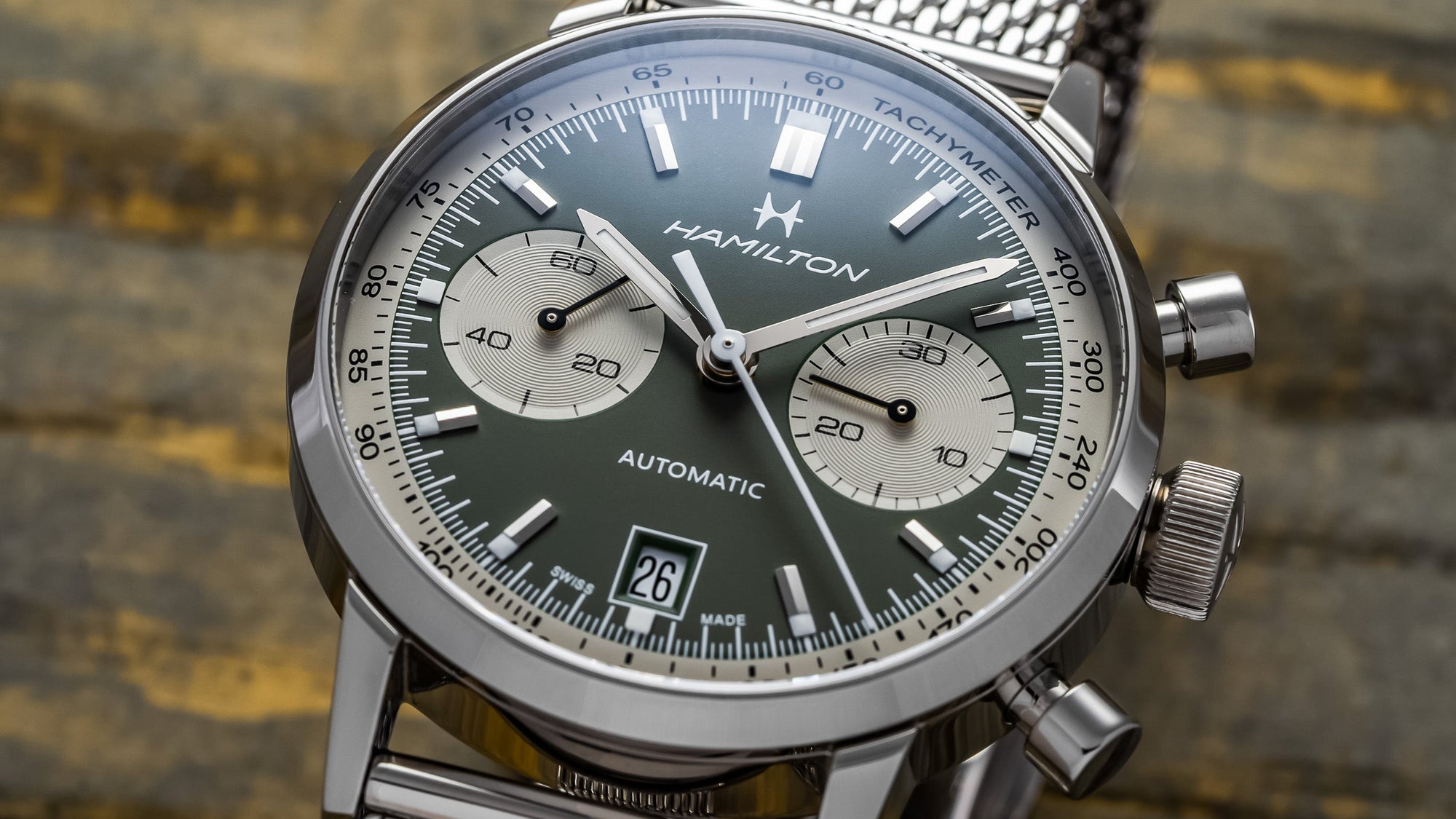The Valjoux 7750 chronograph caliber has been a mainstay of the Swiss watch industry for more than 50 years, finding its way into hundreds of watch models, under many dozens of names, and providing the technical base for numerous high complications over the years. Why is it so ubiquitous and still such an enduring presence in the watch world today? Here is a brief history of the "workhorse" mechanism that became the world's most famous and familiar chronograph movement.
Valjoux 7750 Roots: The Vallée de Joux

Sunset over the Vallée de Joux
In actuality, the origins of the Valjoux 7750 go back much longer than the half-century it has actually been on the market. The company that came to be called “Valjoux” started up at the very beginning of the 20th century, taking its original name, Reymond Frères SA, from its founders, brothers John and Charles Reymond. The company, which specialized in making mechanical chronograph movements for military and sport-oriented timekeepers, changed its name in 1929 to Valjoux — a shortened reference to the scenic Vallée de Joux in Switzerland, where it and many of its client watchmakers were located.
The firm’s most successful and historically impactful creations included the manually wound, column-wheel-driven, monopusher Caliber 22, in 1914, and its even more significant successor, the smaller, longer-lived Caliber 23, in 1916. In honor of the founding brothers' surname, Valjoux movements were inscribed with a shield emblem with a cursive "R."

Venus Caliber 170
Another player enters the backstory of the Valjoux 7750 in 1923: Venus, another well-regarded Swiss maker of chronograph calibers, established in the Swiss canton of Bern in the village of Moutier by Paul Berret, Jean-Baptiste Berret, and Otto Schmidt. (This period of Swiss watchmaking being somewhat murky historically, it’s not clear if this “Venus” company had any relationship to a watchmaking firm founded in 1902 by Paul Arthur Schwarz and Olga Etienne-Schwarz, which made complete watches rather than movements.) Known for the quality of its chronograph movements, which were recognizable by the now-famous five-pointed star emblem, Venus was absorbed into the huge holding company Ébauches SA in 1928, joining many other small horological firms in that era of post-World War I consolidation.
The vintage column-wheel chronographs produced by Venus in the early 20th Century are regarded as some of the best Swiss watch movements in history and highly collectible today — like Caliber 170 and its descendants, a reliable movement with counters in a parallel arrangement at 6 and 12 o’clock used by many contemporary watch brands throughout the 1930s and into the ‘40s. Breitling, for example, used the Venus Caliber 175 in its original Chronomat and Navitimer models.

Breitling Ref. 1191 Chronograph with Venus Caliber 188; Photo: Christie's
Venus’s Caliber 170 family, like Valjoux’s Caliber 23 movements, were designed in the classical column-wheel style, which was (and is still) prized from a technical standpoint, but was also rather expensive to manufacture, a liability for watch companies that were attempting to achieve greater production numbers for their chronograph watches as civilian demand for them began growing after World War II. Venus’s answer was the Caliber 188, which replaced the column wheel with a cam-switching system that was much cheaper to build. Debuting in 1948 and used in watches from Wittnauer, Breitling, and others, it was produced until 1966 — a pivotal year that represented the true genesis of the Valjoux 7750.

Illustration of Valjoux 7733 parts
Despite the reputation for quality it had built up over the years, Venus entered bankruptcy in 1966 and it was swallowed up the same year by its competitor, Valjoux (which had also been absorbed into the Ébauches SA conglomerate in 1944). Recognizing the potential of the cam-switching Venus 188 movement that it now had in its stable— and others it spawned, including the full-calendar Venus 199 and moon-phase-equipped Venus 200 — Valjoux rebranded it as the Valjoux 7730.
In 1969, Valjoux redesigned and renamed the movement as the 7733, adding a date in the 7734 version and a 12-hour counter in the 7736. This 7730 family of Venus-descended chronograph calibers, all with manual winding and cam-switching, found their way into watches from Hamilton, Breitling, IWC, Panerai, and a host of other, lesser known brands into the late 1970s. However, as watch history buffs are aware, there were other major developments in the watch industry in 1969 that were destined to change the landscape forever.
Quartz, El Primero, and the Automatic Chronograph

On the cusp of the 1970s, watchmakers from Switzerland and elsewhere were racing to be the first to the finish line in an industry-wide quest to produce the world’s first self-winding chronograph movement for a watch. Self-winding (or automatic) wristwatches had been around since as early as 1923, and the technology had existed at least since the 1770s, pioneered by legendary watchmakers like Breguet and Perrelet. But an automatic movement that also incorporated the horologically complex and increasingly popular stopwatch function had yet to be perfected for commercial use, despite several years of research and development by a number of companies and consortiums.

The original Zenith El Primero (1969)
The Great Automatic Chronograph Race, as it tends to be remembered today, kicked into high gear in the late 1960s. The major players included Zenith, historically renowned for its ultra-precise chronographs, which had striven to complete the groundbreaking project in its centennial year of 1965 but was now aiming simply to be “the first;” a consortium made up of heritage watchmakers Heuer-Leonidas, Breitling, Buren-Hamilton, and movement maker Dubois-Depraz; and Japan’s Seiko, which, like Zenith was pursuing the project on its own apart from its Swiss competitors.

"Chrono-Matic" Caliber 11 (1969)
Zenith’s movement reached its completed stage first, and was announced at a press conference on January 10, 1969 — beating the Caliber 11 “Chrono-Matic” that arose from the Breitling-Heuer consortium’s efforts, which launched on March 10 of that year, and the Seiko Caliber 6139, which hit the market in May. While Zenith’s groundbreaking movement was not actually available in a commercial product until later in the year, it did live up to the name its creators gave it — “El Primero,” or “The First” — by virtue of its January debut to the public. Regardless of the timing of these various inventions’ commercial debuts, their message to the watch industry and the watch-buying public was clear: automatic chronographs had arrived, and the companies, like Valjoux, which had not taken part in this first generation of their development, would need to quickly respond. For all of the attributes built into the Caliber 7730 family of movements, none of them could not yet wind themselves.
Designing An Iconic Movement

Early drawing of the Valjoux 7750
Valjoux turned to 24-year-old Edmond Capt, a watchmaker and engineer who had previously plied his trade at Rolex, to help develop a new chronograph movement, based on the manually wound 7733, that would be self-winding but still more affordable to mass-produce than the El Primero (which used the classical column-wheel architecture) or Caliber 11 (which used a modular construction). Capt’s team used a massive computer at Valjoux’s headquarters in Neuchâtel, Switzerland, to create the technical drawings and simulations of the movement. Their use of this emerging technology not only enabled the product of all this research to be industrialized much faster than it normally would have; it also ensured that the Valjoux 7750 would go down in history as the first watch movement created using CAD (computer aided design).

The new movement, dubbed the Valjoux 7750, emerged in 1974, measuring 30mm in diameter and just under 8mm thick, with a number of notable elements. It incorporated a historic device called an oscillating pinion, invented in 1887 by Edouard Heuer (that’s the “Heuer” in TAG Heuer) and a new zero-return mechanism designed by Capt, based on a 1940s invention, which used cam-operated levers to operate the chronograph functions rather than a column wheel. Also helping to meet the goal of a movement that would be inexpensive to mass produce, Capt and his engineers used high-strength plastic, rather than steel, for some of the parts. (By the end of the 1990s, these had been replaced with steel parts, and the initial 17 jewels in the movement had increased to 25.)
The Valjoux 7750 was also distinctive in the layout of its chronograph registers — 12-hour counter at 6 o’clock, running seconds at 9, and 30-minute counter at 12 — along with a day-and-date calendar at 3. With its simple, three-plate base and unadorned rotor, the Valjoux 7750 was not as pretty to look at as the Zenith El Primero — or, many would argue, even as attractive as the manually wound Valjoux chronograph calibers that preceded it — but it got the job done, and quickly became the go-to movement for many watchmakers that had yet to develop their own in-house chronograph movements.
Rescuing The Valjoux 7750

Valjoux 7750 (1974)
But let’s circle back to the other major seismic shock that hit the watch industry in 1969. At the same time that the art of mechanical watchmaking was hitting possibly its highest pinnacle in decades with the development of automatic chronograph movements, the emergence of battery-powered quartz movements — substantially more accurate, way cheaper to produce, and mostly coming from Asia — was threatening to upend the entire Swiss watch industry, which was still clinging to centuries-old traditions.
The Valjoux 7750, as well as the El Primero and all the Caliber 11 variants, barely had a chance to get a commercial foothold when senior management at the watchmaking firms that made them ordered a halt in their production. In the cases of Zenith and Valjoux, this mandate also included the destruction of all the components, tools, and blueprints used to manufacture them; as the Quartz Revolution grew into a full-blown Quartz Crisis for Switzerland, the prevailing sentiment among heritage watchmakers and their longtime suppliers was that such inventions were obsolete and the market would never again want them.

ETA headquarters in Switzerland
Fortunately, much like Zenith’s now-legendary “El Primero savior,” Charles Vermot, Edmond Capt quietly defied these orders, secretly stashing as many of the Valjoux 7750 components and documents that he could in the hopes that one day the watch industry would find demand for the movement again. That demand first started bubbling up in 1985, two years after yet another mass industry consolidation, prompted by the Quartz Crisis, changed Valjoux’s ownership structure yet again. The company was absorbed, lock, stock, and mainspring barrel, into ETA, which in turn formed one of the pillars of what is today known as the Swatch Group.

Image by The Naked Watchmaker
It is a long and convoluted corporate history, which I promise to explore more deeply in another article down the road, but for our purposes here, suffice it to say that Valjoux, along with all the other historical firms that made up Ébauches SA, effectively ceased to exist and the Valjoux 7750 would henceforth be known officially as the ETA 7750. For possibly sentimental reasons, many sources still use the original name, or refer to it as the ETA Valjoux 7750. Whatever its nomenclature, Capt’s insubordinate gambit paid off, and production of the 7750 resumed in 1985. Capt himself went on to a distinguished career in the new era of watchmaking, creating more than 30 new movements for various firms, including the Swatch Group-owned Blancpain and Breguet, where he served as General Director. As for the Valjoux 7750, its place in horological history had barely begun.
Growing The Valjoux 7750 Family

The Tissot PRX Chronograph uses the ETA Valjoux 7753
As with many popular and reliable mass-produced watch movements, the Valjoux 7750 has been enhanced and built up over time with many additional complications and functions. To highlight just a few of them, there’s the 7751, introduced in 1991, which adds a day/month/date calendar, a GMT hand, and a moon-phase indication; the 7753, rolled out in 2002, with a revised subdial layout with the minutes counter at 3:00 and date window at 4:30 (as on the Tissot PRX Chronoograph, above); and the 7760 family, launched in 2005, which dispenses with the automatic winding mechanism in favor of more old-school manual winding — somewhat ironic in conception, considering the reasons for the original caliber’s existence in the first place, but reminiscent of historical predecessors from Valjoux and Venus. The 7770, also debuting in 2002, was a souped-up version with a rattrapante, or flyback function, added to the integrated chronograph.

Longines Avigation Watch Type A-7 1935
In 2004, as a response to the growing early-aughts popularity of “oversized” watches, ETA essentially gave the Valjoux 7750 a big brother. The Valgranges series of movements (“Val” for Vallée de Joux, “Granges” for the name of the movements’ production site) used the original 7750 as a base and expanded the dimensions to be used in larger watches — 36.6mm, as compared to the 30mm of its ancestor. Of the many Valgranges variants that were rolled out in the next few years, only a handful were chronographs, though the series did include other complications and functions, such as 24-hour timekeeping, retrograde dates, and power-reserve indicators. Big, bold watches like the Longines Avigation Watch Type A7 1935 (above) commonly used Valgranges calibers during this era. As trends swung back toward smaller wristwatches, however, this series of Valjoux-derived movements was retired in 2021.

IWC Da Vinci Perpetual Calendar (1985)
Aside from its own evolution as a movement, the Valjoux 7750 has played an almost Forrest Gump-like role in the watch industry, making its presence felt in some of the most important historical milestones achieved by watch brands. When Breitling launched the modern version of the Chronomat in the mid-1980s, it put a Valjoux 7750 inside the case. IWC Schaffhausen turned to the Valjoux 7750 as the base for two of its most significant achievements — the trendsetting Da Vinci Perpetual Calendar created by Kurt Klaus in 1985, and the Pilot’s Watch Doppelchronograph in 1992, for which legendary watch designer Richard Habring used the 7750 as the stage for that model’s complex split-seconds chronograph mechanism.
IWC in particular has made the Valjoux 7750 the foundation of many extremely complicated timepieces over the years, including the legendary Destrerio Scafusia, also in collaboration with Habring, which combined a split-seconds chronograph, perpetual calendar, tourbillon, and minute repeater.

Fortis Official Cosmonauts Chronograph
Another renowned independent watchmaker, Zurich-based Paul Gerber, used the 7750 as the base for the world’s first automatic chronograph with an added mechanical alarm function (Caliber F-2001), which debuted in the Fortis Official Cosmonauts Titanium Alarm Chronograph watch in 1994. TAG Heuer’s Caliber 16, which powered the first modern relaunch of the brand’s emblematic racing chronograph, the Carrera, was a variant of either the 7750 or the slightly redesigned 7753.
Other major brands that have utilized and modified the Valjoux 7750 include Omega (Caliber 1164, inside the Speedmaster Date); Breitling (Caliber B23); Longines (Caliber L688, which incorporated the column-wheel architecture to which the original 7750 was designed to provide an alternative); and Hublot (Caliber HUB4100, which powered the first Big Bang in 2005). Chronoswiss, one of the modern pioneers of skeleton watch movements, skeletonized a Valjoux 7750 to create the movement showcased in its Opus model. All told, the Valjoux 7750, aka the ETA 7750, probably can claim more aliases than an international undercover spy.

Sellita SW500, the "clone" Valjoux 7750
The enduring appeal of the Valjoux 7750 is perhaps most plainly seen in light of changes in the watch industry within the past 20 years that have spurred more and more watchmaking brands, many of which were historically big customers of ETA and its Valjoux-based movements, to either develop their own in-house movements or seek out other suppliers . The catalyst for much of these changes was the Swatch Group’s announcement in 2002 that ETA would eventually cease selling its movements to companies outside the Group. That meant that brands like Omega, Hamilton, Longines, Tissot, Rado, and Mido would still have access to ETA base calibers (along with a few other high-profile, longtime client brands, grandfathered in at least for a while) but others would not.
In the interim, manufacturers like Breitling, Panerai, IWC, Tudor, and others ramped up their vertical integration to make at least some of their own movements in-house, while other brands turned to ETA competitors like Sellita, whose SW 500 caliber is essentially a “clone” of the ETA 7750. Not a bad legacy for a “workhorse” caliber that was rushed to the market to undercut its legendary competitors on price and reliability. More than half a century after its debut, it’s difficult to imagine the watch industry today without the invention of the Valjoux 7750 and the further innovations that it made possible.

























































0 Comments